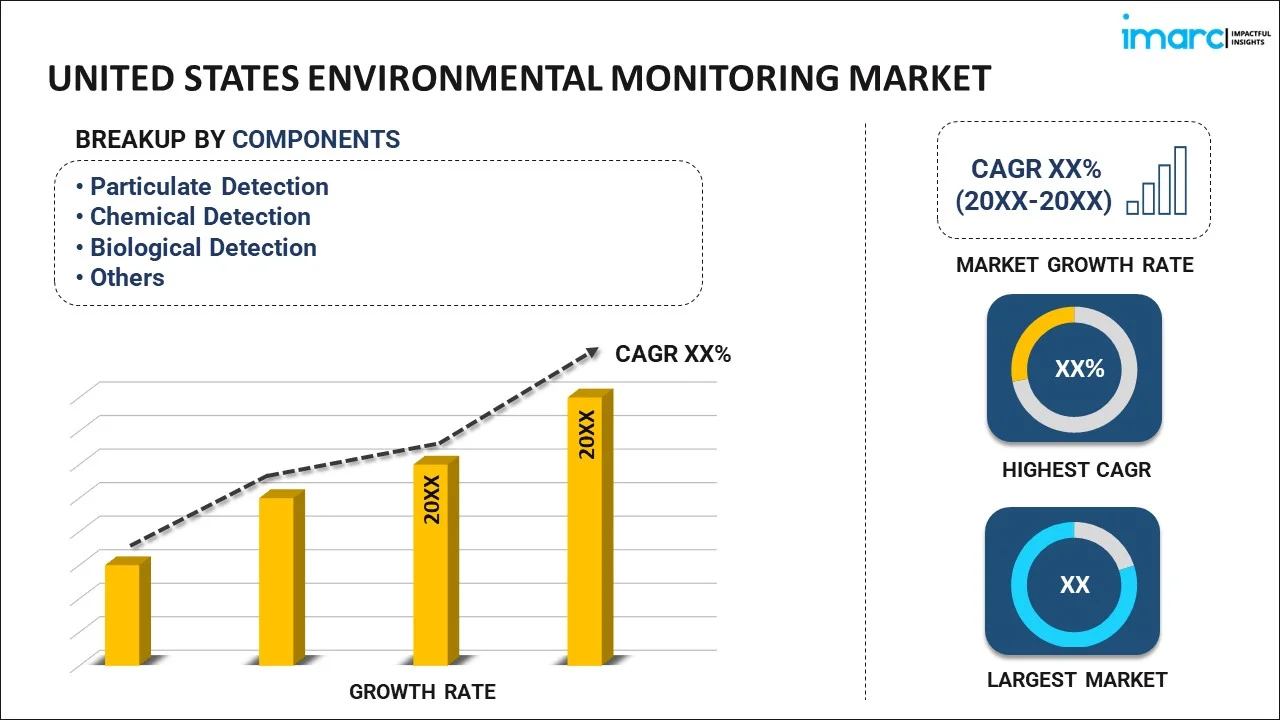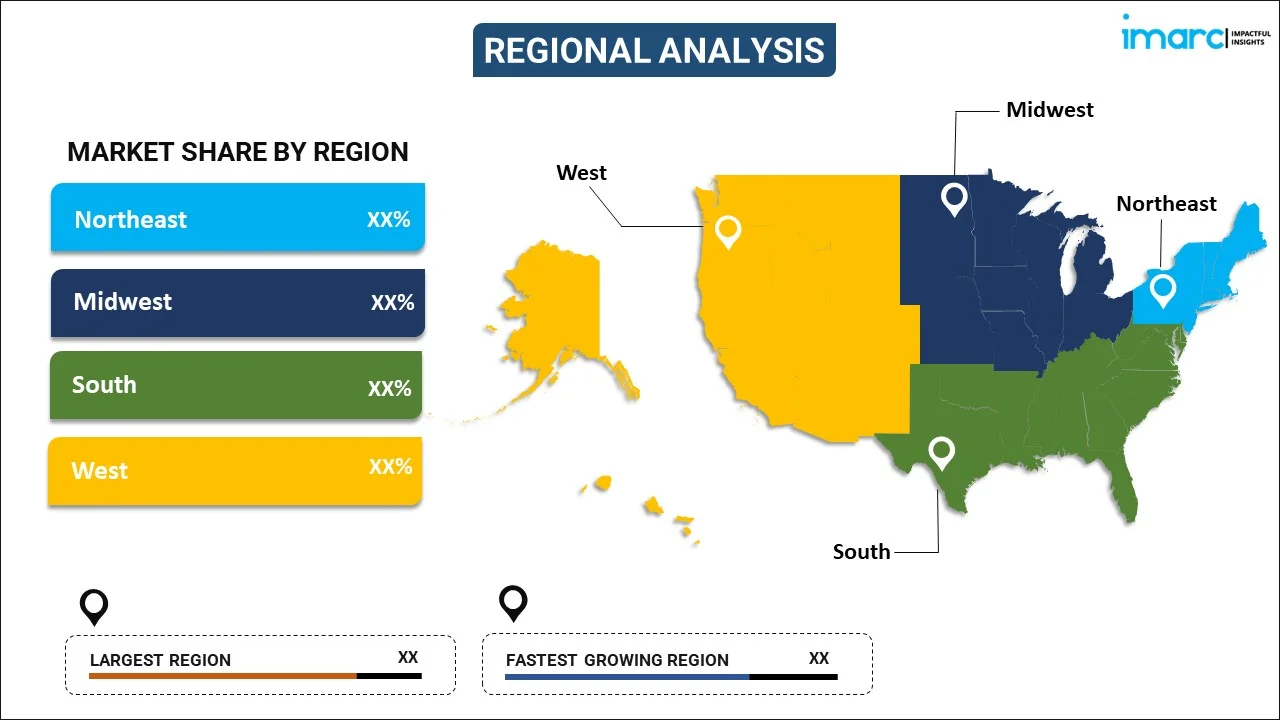
United States Environmental Monitoring Market Report by Component (Particulate Detection, Chemical Detection, Biological Detection, Temperature Sensing, Moisture Detection, Noise Measurement), Product Type (Environmental Monitoring Sensors, Environmental Monitors, Environmental Monitoring Software, Wearable Environmental Monitors), Sampling Method (Continuous Monitoring, Active Monitoring, Passive Monitoring, Intermittent Monitoring), Application (Air Pollution Monitoring, Water Pollution Monitoring, Soil Pollution Monitoring, Noise Pollution Monitoring), and Region 2025-2033
Market Overview:
United States environmental monitoring market size reached USD 5.4 Billion in 2024. Looking forward, IMARC Group expects the market to reach USD 9.7 Billion by 2033, exhibiting a growth rate (CAGR) of 6.7% during 2025-2033. The widespread adoption of cutting-edge technologies to address complex environmental challenges and the launch of favorable policies by government bodies to promote responsible resource management are primarily driving the market growth across the country.
|
Report Attribute
|
Key Statistics
|
|---|---|
|
Base Year
|
2024
|
|
Forecast Years
|
2025-2033
|
|
Historical Years
|
2019-2024
|
|
Market Size in 2024
|
USD 5.4 Billion |
|
Market Forecast in 2033
|
USD 9.7 Billion |
| Market Growth Rate 2025-2033 | 6.7% |
Environmental monitoring encompasses the application of diverse tools and methodologies to evaluate the consequences of activities on the environment. Central to this process is a data management hub, incorporating features like compliance checking validation, automated environmental monitoring alerts, and stringent quality control measures. This multifaceted approach plays a critical role in safeguarding public water supplies, overseeing the handling of hazardous and radioactive waste, and pinpointing sources of pollution. Beyond these functions, environmental monitoring allocates resources for effective land planning and economic development, aids in the protection of endangered species, mitigates risks, and upholds human health standards. As such, the practice of environmental monitoring aids in ensuring responsible and sustainable practices across various industries and sectors.
United States Environmental Monitoring Market Trends:
In the United States, the environmental monitoring market is witnessing a transformative phase, driven by key drivers and shaped by prominent trends. One significant driver is the escalating awareness among individuals towards environmental sustainability, compelling industries to adopt advanced monitoring technologies. Moreover, stringent regulations and increasing concerns about pollution and climate change are propelling the demand for real-time, accurate environmental data. Besides this, technological advancements in sensor capabilities and data analytics represent another crucial driver in the United States. Innovations, such as remote sensing, satellite imagery, and IoT-enabled devices, are revolutionizing environmental monitoring, providing more comprehensive and timely insights. Besides this, the elevating integration of artificial intelligence (AI) and machine learning (ML) with environmental monitoring software is positively influencing the market growth across the country. These technologies enhance data processing, enabling more effective analysis and interpretation of vast datasets. This trend contributes to the development of predictive models and actionable insights for better decision-making. Cloud-based environmental monitoring solutions are gaining traction, offering scalability, accessibility, and improved data management. Furthermore, this shift towards cloud technology allows for efficient storage, retrieval, and sharing of data across diverse stakeholders, which is anticipated to fuel the United States environmental monitoring market over the forecasted period.
United States Environmental Monitoring Market Segmentation:
IMARC Group provides an analysis of the key trends in each segment of the market, along with forecasts at the country level for 2025-2033. Our report has categorized the market based on component, product type, sampling method, and application.
Component Insights:

- Particulate Detection
- Chemical Detection
- Biological Detection
- Temperature Sensing
- Moisture Detection
- Noise Measurement
The report has provided a detailed breakup and analysis of the market based on the component. This includes particulate detection, chemical detection, biological detection, temperature sensing, moisture detection, and noise measurement.
Product Type Insights:
- Environmental Monitoring Sensors
- Environmental Monitors
- Environmental Monitoring Software
- Wearable Environmental Monitors
A detailed breakup and analysis of the market based on the product type have also been provided in the report. This includes environmental monitoring sensors, environmental monitors, environmental monitoring software, and wearable environmental monitors.
Sampling Method Insights:
- Continuous Monitoring
- Active Monitoring
- Passive Monitoring
- Intermittent Monitoring
The report has provided a detailed breakup and analysis of the market based on the sampling method. This includes continuous monitoring, active monitoring, passive monitoring, and intermittent monitoring.
Application Insights:
- Air Pollution Monitoring
- Water Pollution Monitoring
- Soil Pollution Monitoring
- Noise Pollution Monitoring
A detailed breakup and analysis of the market based on the application have also been provided in the report. This includes air pollution monitoring, water pollution monitoring, soil pollution monitoring, and noise pollution monitoring.
Regional Insights:

- Northeast
- Midwest
- South
- West
The report has also provided a comprehensive analysis of all the major regional markets, which include Northeast, Midwest, South, and West.
Competitive Landscape:
The market research report has also provided a comprehensive analysis of the competitive landscape. Competitive analysis such as market structure, key player positioning, top winning strategies, competitive dashboard, and company evaluation quadrant has been covered in the report. Also, detailed profiles of all major companies have been provided.
United States Environmental Monitoring Market Report Coverage:
| Report Features | Details |
|---|---|
| Base Year of the Analysis | 2024 |
| Historical Period | 2019-2024 |
| Forecast Period | 2025-2033 |
| Units | Billion USD |
| Scope of the Report | Exploration of Historical and Forecast Trends, Industry Catalysts and Challenges, Segment-Wise Historical and Predictive Market Assessment:
|
| Components Covered | Particulate Detection, Chemical Detection, Biological Detection, Temperature Sensing, Moisture Detection, Noise Measurement |
| Product Types Covered | Environmental Monitoring Sensors, Environmental Monitors, Environmental Monitoring Software, Wearable Environmental Monitors |
| Sampling Methods Covered | Continuous Monitoring, Active Monitoring, Passive Monitoring, Intermittent Monitoring |
| Applications Covered | Air Pollution Monitoring, Water Pollution Monitoring, Soil Pollution Monitoring, Noise Pollution Monitoring |
| Regions Covered | Northeast, Midwest, South, West |
| Customization Scope | 10% Free Customization |
| Post-Sale Analyst Support | 10-12 Weeks |
| Delivery Format | PDF and Excel through Email (We can also provide the editable version of the report in PPT/Word format on special request) |
Key Questions Answered in This Report:
- How has the United States environmental monitoring market performed so far and how will it perform in the coming years?
- What has been the impact of COVID-19 on the United States environmental monitoring market?
- What is the breakup of the United States environmental monitoring market on the basis of component?
- What is the breakup of the United States environmental monitoring market on the basis of product type?
- What is the breakup of the United States environmental monitoring market on the basis of sampling method?
- What is the breakup of the United States environmental monitoring market on the basis of application?
- What are the various stages in the value chain of the United States environmental monitoring market?
- What are the key driving factors and challenges in the United States environmental monitoring?
- What is the structure of the United States environmental monitoring market and who are the key players?
- What is the degree of competition in the United States environmental monitoring market?
Key Benefits for Stakeholders:
- IMARC’s industry report offers a comprehensive quantitative analysis of various market segments, historical and current market trends, market forecasts, and dynamics of the United States environmental monitoring market from 2019-2033.
- The research report provides the latest information on the market drivers, challenges, and opportunities in the United States environmental monitoring market.
- Porter's five forces analysis assist stakeholders in assessing the impact of new entrants, competitive rivalry, supplier power, buyer power, and the threat of substitution. It helps stakeholders to analyze the level of competition within the United States environmental monitoring industry and its attractiveness.
- Competitive landscape allows stakeholders to understand their competitive environment and provides an insight into the current positions of key players in the market.
Need more help?
- Speak to our experienced analysts for insights on the current market scenarios.
- Include additional segments and countries to customize the report as per your requirement.
- Gain an unparalleled competitive advantage in your domain by understanding how to utilize the report and positively impacting your operations and revenue.
- For further assistance, please connect with our analysts.
 Inquire Before Buying
Inquire Before Buying
 Speak to an Analyst
Speak to an Analyst
 Request Brochure
Request Brochure
 Request Customization
Request Customization




.webp)




.webp)












